Table of Contents
What is Motivation in Organisational Behaviour?
The word motivation is coined from the Latin word “movere”, which means to move. Motivation is defined as an internal drive that activates behavior and gives it direction.
The term ‘motivation theory’ is concerned with the processes that describe why and how human behavior is activated and directed. It is regarded as one of the most important areas of study in the field of organizational behavior.
Motivation is the art of stimulating people to get the desired things done. A motive is a need or desire which stimulates and directs human behavior. It is possible only when their needs are satisfied through proper incentives or rewards.
Human behavior is thus, the result of needs, desires, and wants. Motivation involves the creation of a positive will and desire among the workers to do their work in the best manner.
Definition of Motivation
These are some simple definitions of motivation:
Motivation is the act of stimulating someone or oneself to get a desired course of action, to push the right button to get the desired reaction.
Michael, J. Jucius
Motivation can be defined as a willingness to expand energy to achieve a goal or a reward.
Dale, S. Beach
The concept of motivation is mainly psychological. It relates to those forces operating within the individual employees or subordinates which compel them to act or not to act in certain ways.
D.E. Mc. Farland
On the basis of the analytical study of the above definitions, it may be concluded that motivation is a process that inspires the human efforts of an organization to perform their duties in the best possible manner so that the predetermined objectives of the enterprise may be achieved.
Motivation is the emotion or desire of an employee that inspires him to act or not to act in certain ways.
Elements of Motivation
These are the elements of motivation in an organization:
- Incentive
- Unending Process
- Psychological Concept
- Power to Act
- Increase in Efficiency
- Increase in Morale
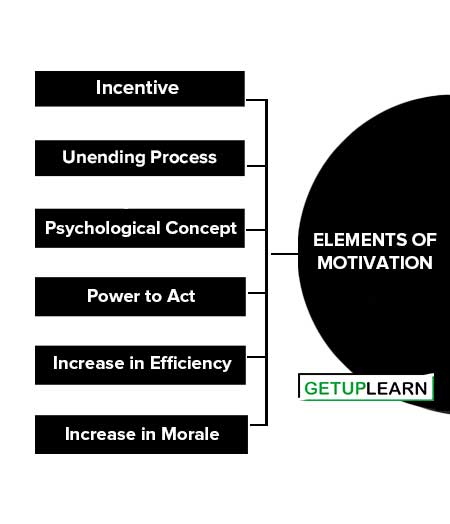
Incentive
Motivation is the incentive for employees. It is a personal and natural feeling in the minds of the employees. This feeling arises in the mind of an individual. In fact, an individual is inspired to make efforts to satisfy the needs of his life.
Unending Process
Motivation is an unending process. Human needs are unlimited and people always feel a need. To satisfy these needs, the person must always be inspired by the incentives for work. Satisfaction of one need leads to the feeling of another one and this process never ends.
Psychological Concept
Motivation is a psychological concept. It develops the mental and motivational power of an individual and motivates him to do more and better.
Power to Act
Motivation is the power to act. It inspires an individual to work. Feeling of a need creates tension and a person wants to work to satisfy his need. When the need is satisfied, the persons feel motivated to work for the achievement of common goals.
Increase in Efficiency
Motivation increases the efficiency of an individual. He uses his ability and efficiency to the best possible extent which increases his efficiency. Motivation increases the quantity and quality of production.
Increase in Morale
Morale is a group feeling. Motivation motivates the employees to work with the cooperation of others. Thus, motivation is helpful in increasing the morale of the employees.
Objectives of Motivation
The following are the objectives of motivation in an organization:
- . To motivate the employees to do more work.
- To satisfy the economic, social, and psychological needs of the employees.
- To develop human relations in the enterprise.
- To increase the morale of employees.
- To increase the efficiency of employees.
- To get the co-operation of employees.
- To establish sweet relations between labor and capital.
- To get the maximum exploitation of human resources.
- To achieve the objectives of the enterprise.
Factors Affecting Motivation
Factors affecting motivation may be divided into the following parts:
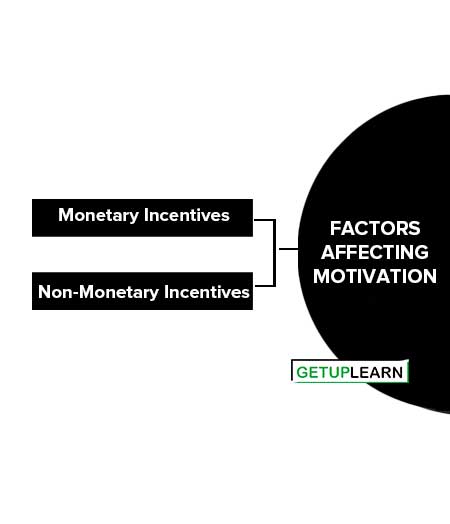
Monetary Incentives
Monetary incentives are direct incentives provided to the employees of an enterprise. It includes the following incentives: (a) Proper wage or salary (b) Bonus (c) Overtime (d) Monetary rewards and (5) Interest on investments. Monetary incentives satisfy the basic needs of employees.
Non-Monetary Incentives
Monetary incentives are not sufficient to ensure more and better work by employees. Non-monetary incentives are also provided to them to motivate them in the right direction. Such incentives motivate them to do more and more work. The following factors are included under this category:
- Safety of work
- Appraisal of work
- Honor of employees
- Behavior with employees
- Opportunities of promotion
- Delegation of authorities
- To increase the feelings and suggestions of employees
- To launch welfare schemes for the employees like housing facilities, medical facilities, recreation facilities, education facilities, insurance, etc.
- Co-partnership in management.
Importance of Motivation
Motivation is very important for an organization because of the following benefits it provides:
- Puts Human Resources Into Action
- Improves Level of Efficiency of Employees
- Leads to Achievement of Organizational Goals
- Builds Friendly Relationship
- Leads to Stability of Workforce
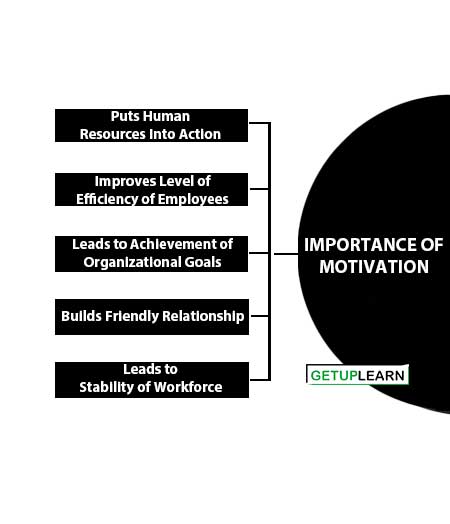
Puts Human Resources Into Action
Every concern requires physical, financial, and human resources to accomplish the goals. It is through motivation that human resources can be utilized by making full use of it. This can be done by building willingness in employees to work. This will help the enterprise in securing the best possible utilization of resources.
Improves Level of Efficiency of Employees
The level of a subordinate or an employee does not only depend upon his qualifications and abilities. For getting the best of his work performance, the gap between ability and willingness has to be filled which helps in improving the level of performance of subordinates. This will result into:
- Increase in productivity
- Reducing the cost of operations,
- Improving overall efficiency.
Leads to Achievement of Organizational Goals
The goals of an enterprise can be achieved only when the following factors take place:
- There is the best possible utilization of resources,
- There is a cooperative work environment,
- The employees are goal-directed and they act in a purposive manner,
- Goals can be achieved if co-ordination and cooperation take place simultaneously which can be effectively done through motivation.
Builds Friendly Relationship
Motivation is an important factor that brings employees satisfaction. This can be done by keeping into mind and framing an incentive plan for the benefit of the employees. In order to build a cordial, friendly atmosphere in a concern, the above steps should be taken by a manager. This would help in:
- Effective cooperation which brings stability,
- Industrial disputes and unrest among employees will be reduced,
- The employees will be adaptable to the changes and there will be no resistance to the change,
- This will help in providing a smooth and sound concern in which individual interests will coincide with organizational interests,
- This will result in profit maximization through increased productivity.
Leads to Stability of Workforce
The stability of the workforce is very important from the point of view of reputation and goodwill of a concern. The employees can remain loyal to the enterprise only when they have a feeling of participation in the management.
The skills and efficiency of employees will always be of advantage to employees as well as employees. This will lead to a good public image in the market which will attract competent and qualified people into concern. As it is said, “Old is gold” which suffices with the role of motivation here, the older the people, the more the experience and their adjustment into a concern which can be of benefit to the enterprise.
Motivation is important to an individual as:
- Motivation will help him achieve his personal goals.
- If an individual is motivated, he will have job satisfaction.
- Motivation will help in the self-development of individuals.
- An individual would always gain by working with a dynamic team.
Similarly, motivation is important to a business as:
- The more motivated the employees are, the more empowered the team is.
- The more teamwork and individual employee contribution, the more profitable and successful is the business.
- During the period of amendments, there will be more adaptability and creativity.
- Motivation will lead to an optimistic and challenging attitude at the workplace.
Motivating Employees in Organizations
A number of motivation theories have been discussed above. Based on these theories, the following suggestions summarize the essence of motivating employees in organizations:
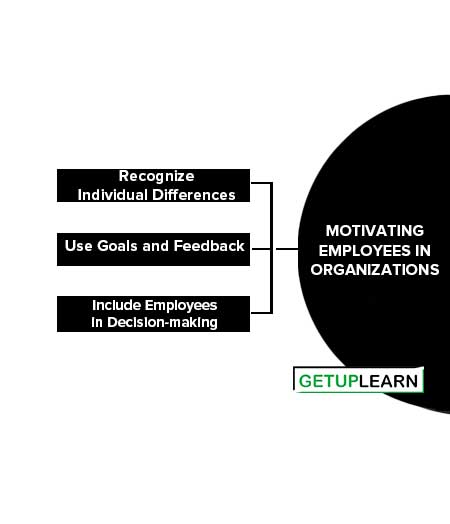
Recognize Individual Differences
Employees have different needs. Therefore, managers need to understand what is important to each employee. This will allow individualizing goals, levels of involvement, and rewards to align with individual needs.
Use Goals and Feedback
Employees should have tangible and specific goals. Feedback should also be provided regularly to inform the employees about their performance in pursuit of those goals.
Include Employees in Decision-making
Employees should be included in making decisions that affect them, for example, choosing their own benefits, and solving productivity and quality problems.
Motivational Tools
Some of the most important motivational tools have been discussed below:
- Management by Objective (MBO)
- Employee Recognition Programmes
- Employee Involvement Programmes
- Participative Management
- Quality Circles (QC)
- Employee Stock Ownership Plans (ESOPs)
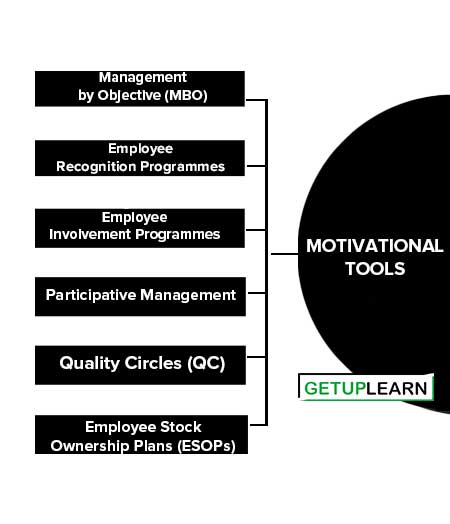
Management by Objective (MBO)
Management by objectives emphasizes participatively set goals that are tangible, verifiable, and measurable. Four ingredients common to MBO programs are goal specificity, participative decision-making, an explicit time period, and performance feedback (Robbins, 2003):
-
Goal Specificity: The objectives in MBO should be concise statements of expected accomplishments.
-
Participative Decision-Making: The manager and employee jointly choose the goals and agree on how they will be measured.
-
An Explicit Time Period: Each objective has a specific time period in which it is to be completed.
- Performance feedback: Continuous feedback on progress toward goals is provided so that workers can monitor and correct their own actions.
MBO and Goal-Setting Theory are closely linked. Goal-setting theory proposes that tangible goals result in a higher level of individual performance than easy goals. Feedback on one’s performance leads to higher performance. MBO also directly advocates specific goals and feedback, implying that goals must be perceived as feasible and is most effective when the goals are difficult enough to require stretching.
Employee Recognition Programmes
Employee recognition programs consist of personal attention, expressing interest, approval, and appreciation for a job well done. They can take numerous forms. Employee Recognition Programmes have a close link with Reinforcement Theory.
Both concepts advocate that rewarding behavior with recognition would lead to its repetition. Recognition can take many forms, such as, personally congratulating an employee, sending a handwritten note or an e-mail message, or declaring the employee as a valuable contributor to the organizational objective.
Employee Involvement Programmes
Employee involvement includes participative management, workplace democracy, empowerment, and employee ownership. Employees’ involvement in the decision-making would positively affect them and by increasing their autonomy and control over their work lives, employees will become more motivated, more committed to the organization, more productive, and more satisfied with their jobs.
Some forms of employee involvement have been discussed here: participative management, representative participation, quality circles, and employee stock ownership plans.
Participative Management
Participative management is a process where subordinates share a significant degree of decision-making power with their immediate supervisors.
The manager involves subordinates in decision-making, consults with them about their views of the situation, asks for their suggestions, considers those suggestions in making a decision, and sometimes lets the subordinates make the decisions themselves. The logic behind participative management is:
- Managers often do not know everything their employees do.
- Better decisions
- Increased commitment to decisions
- Intrinsically rewarding employees make their jobs more interesting and meaningful.
The two most common forms of participative management are:
-
Works Councils: They are groups of nominated or elected employees who must be consulted when management makes decisions.
- Board Representatives: They are employees who sit on a company’s board of directors and represent the interests of the firm’s employees.
Quality Circles (QC)
Quality Circles consist of a workgroup of eight to ten employees and supervisors who have a shared area of responsibility. Quality circles are small groups of employees who work voluntarily on company time to address quality-related problems such as quality control, cost reduction, production planning and techniques, and even product design. Key components of QC are (Robbins, 2003):
- They meet regularly on company time to discuss their quality problems, investigate the causes of the problems, recommend solutions, and take corrective actions.
- They take over the responsibility for solving quality problems and they generate and evaluate their own feedback.
Employee Stock Ownership Plans (ESOPs)
Perhaps the ultimate reward to workers is for them, to own part of the organization. Employee stock ownership plans are company-established benefit plans in which employees acquire stock as part of their benefits ESOPs have the potential to increase employee job satisfaction and work motivation.
Special Issues in Motivation
Various groups of employees provide specific challenges in terms of motivation. Some of them are explained below:

Motivating Diversified WorkForce
Not everyone is motivated by money. The needs of women physically disabled and other diverse groups are not the same. If you are going to maximize your employees’ motivation, you have got to understand and respond to this diversity. This can be done in the following ways:
- We should be ready to design work schedules, compensation plans, benefits, and physical work settings, etc., to reflect the employees’ varied needs.
-
Link Rewards to Performance: Rewards should be contingent on performance and employees must perceive a clear linkage.
-
Maintain Equity: Rewards should be perceived by employees as equating with the inputs they bring to the job, i.e.; experience, skills, abilities, effort, and other obvious inputs should explain differences in performance and, hence, pay, job assignments, and other obvious rewards.
-
Link Rewards to Performance: Rewards should be contingent on performance and employees must perceive a clear linkage.
- Allowing employees who are going for further training to colleges to vary their work schedule.
- Offering employees facilities like childcare, flexible work hours, and job sharing for employees with family responsibilities.
- For employees coming from other states /countries providing them flexible leave possibilities to enable them to go home for extensive periods.
Motivating Temporary Workers
Temporary workers may be motivated in the following ways:
- When there is a system whereby permanent employees are selected from a pool of temporary employees, the latter will often work hard in hopes of becoming permanent.
- The ability of a temporary employee to find a new job is largely dependent on his or her skills. Therefore, temporary employees may be provided with the opportunity for training.
- When temporary employees work alongside permanent employees who earn more pay for doing the same job, they are likely to be demotivated. Separating such employees might help to lessen this problem.
Motivating Professionals
Professionals have a strong and long-term commitment to their field of expertise. Their loyalty is more often to their profession than to their employer. These professionals receive a great deal of intrinsic satisfaction from their work. They may be motivated in the following ways:
- Their loyalty is toward their profession. To keep current in their fields, they need to regularly update their knowledge. Therefore, providing them with opportunities for training and development is one sure way of motivating them. Reward them with educational opportunities – staging workshops, attending conferences – that allow them to keep current in their field.
- The chief reward of a professional is the job itself. They prefer challenging jobs. Therefore, provide them with ongoing challenging projects.
- Professionals want others to think what they are working on is important. Therefore, ask questions and engage in other actions that demonstrate that you are sincerely interested in what they are doing.
FAQs Section
What are the elements of motivation?
Incentive, Unending Processes, Psychological Concepts, Power to Act, Increase in Efficiency, and Increase in Morale are the elements of motivation.
What are the motivational tools?
The following are the motivational tools:
1. Management by Objective (MBO)
2. Employee Recognition Programmes
3. Employee Involvement Programmes
4. Participative Management
5. Quality Circles (QC)
6. Employee Stock Ownership Plans (ESOPs).
